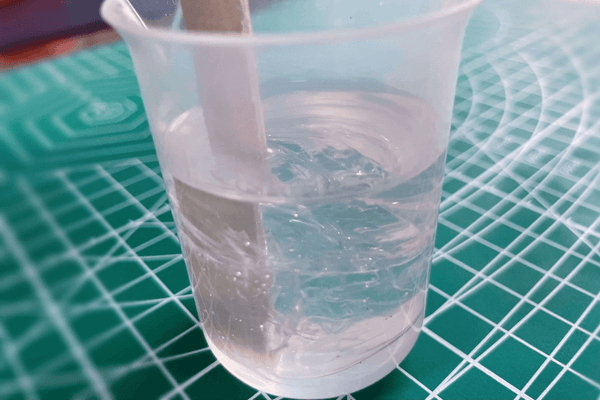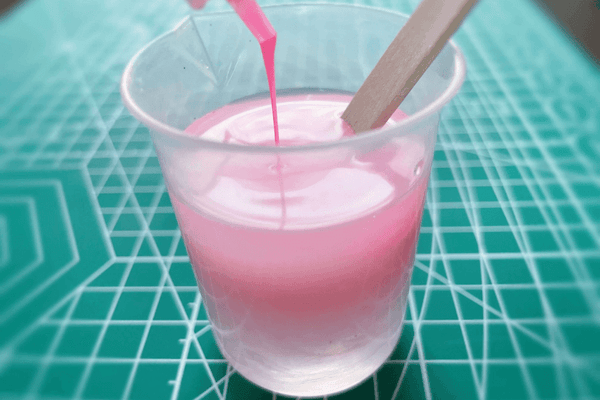If you're new at using epoxy, you may have a hard time curing the resin completely. They are not sticky or tacky at all, but you'll find that they always end up soft and bendy after 48 hours or even a week due to a few causes that you don't take care of. In this guide, we'll list a few possible reasons and tips that may help you out.
Quick Link [hide]
Why is My Resin Bendy
 Not Enough Curing Time
Not Enough Curing Time
The curing time depends on different brand epoxy. IntoResin epoxy needs 12-24 hours to cure (If thin items, they will be a little bendy) and around 72 hours to fully cure. Try to check your resin curing time, if it just needs more time for a fully cure, then you're lucky. You just need to simply give it more time and way to go!
 Thin Layer
Thin Layer
At least ⅓ of an inch thick, or it's normal that your resin will be warp and bendy. If not that thick, what you can do is to give it more time to cure.
💡P.S. If you're going pour thin resin, try to use polyurethane resin. Lear more here if you have no idea what it is.

 Inaccurate Measuring
Inaccurate Measuring
IntoResin epoxy mixing ratio is 1:1 by volume. It's not a simple math. You need to know resin weighs more than hardener, so keep in mind that you should measure by volume rather than weight. However, the mixing error range can be allowed, which means your resin can still turn from liquid to solid but may be bendy even if you let it cure a few days or more.
 Inadequate Mixing
Inadequate Mixing
At least take 3~5 minutes to mix the resin thoroughly so chemical reaction between the resin and hardener was able to take place. Keep in mind that scraping the sides and bottom of the mixing container.

 Excessive Colorant
Excessive Colorant
It is recommended to add no more than 6% of color from the total volume of hardener and resin together. If your piece needs 50ml compound, you'd better add less than 3ml colorant. It is noted that this would apply to all colorants so it really is your preference which kind you use.

 High Temperature & Moisture
High Temperature & Moisture
If your resin hasn’t been stored properly, when exposed to heat, your cured resin may soften a bit and if it isn't on a flat surface it may bend. And It usually doesn’t bend immediately but over time. Also, extra moisture makes your resin cure bendy and cloudy.
💡P.S. Acrylic paints attract moisture which may make resin bendy.
How to Fix Bendy Resin
Simply put, if the resin piece is not thin, you should be patient and give your resin more time (3-7 days) to cure completely.
If it is still bendy or not cured completely after a few days, then the resin may not cure harder any more because your resin is likely to fall into the improper measuring, mixing, colorant and etc.
Tips & Tricks
Conclusion
Anyway, bendy resin is not always a big challenge in the process of making resin crafts. So do not feel depressed when it happens. It acts as a stepping stone to help you make progress to become resin expert. :) If you're a beginner, and things seem a bit too complicated. No worries, we’ve got you covered. Join our Facebook group to ask for help and create with thousands of people who are also resin lovers!
FAQs
Is bendy resin toxic?
Normally, it's not toxic but it depends on which brand epoxy you used. I'd be personally less confident about the skin wear safety of soft resin piece.
Is bendy resin still ok to sell?
It depends on if your resin piece is still ok to be used.

2 comments
@Terri If your tabletop made with UV resin bends when placed on an uneven surface, it could be due to a few factors:
Insufficient support: The tabletop may not have enough structural support underneath, causing it to bend under its own weight. Consider adding additional support, such as braces or reinforcement underneath the tabletop, to ensure it remains flat and stable.
Inadequate curing: It’s possible that the resin was not fully cured during the initial curing process. If the resin is not completely cured, it may remain flexible and prone to bending. Ensure that you follow the recommended curing time and properly expose the resin to UV light for the specified duration.
Incorrect resin-to-hardener ratio: If you mix the resin and hardener in incorrect proportions, it can affect the final hardness and stability of the cured resin. Make sure to carefully measure and mix the resin and hardener in the correct ratio, as specified by the manufacturer’s instructions.
Environmental factors: Extreme temperature and humidity fluctuations can impact the stability of the resin over time. If the tabletop was exposed to significant temperature changes or high humidity, it could affect its shape and cause it to bend. Consider the environmental conditions and try to maintain a stable environment during the curing and storage process.
If you have tried different resin types and measured correctly, it may be worth reassessing the structural integrity of the tabletop and considering additional support. If the issue persists, it could be helpful to consult with experts in resin casting or reach out to the manufacturer for further guidance specific to the resin types you are using.